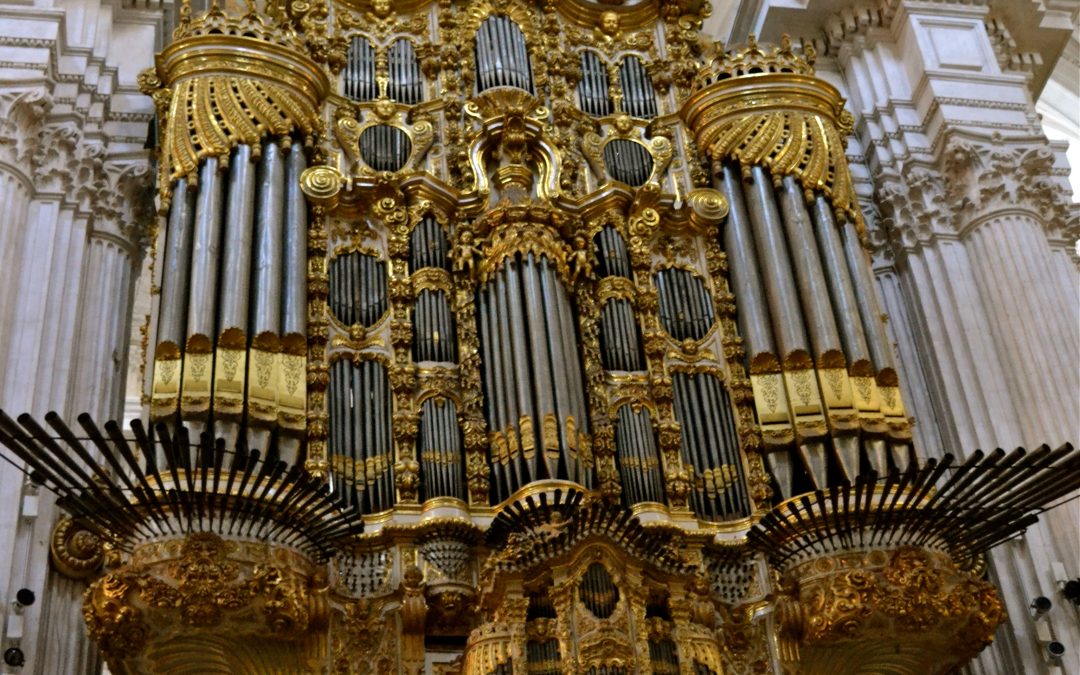A Singing Culture
One Sunday, we went to a neighborhood church in Spain, to find there were no instruments to accompany the hymns. This was a bit disappointing because the church had a beautiful organ (at least to the eye) that sat untouched. The voices of the congregation, however, made up for the lack of accompaniment. The song leader performed a cappella and the entire congregation sang along—everyone in tune. The biggest surprise was that none of the men or older women dropped down an octave as we hear so often in this country.
Center of the Church
In Spanish cathedrals, music sits in the center of the nave. Two massive organs, each with full ranks
 |
|
Choir in Cathedral at Seville
|
of pipes, border a large room, usually with partial walls topped with grates and wrought metal doors. Ornate choir stalls line the room and an antique music stand usually stands in place of prominence. This space almost overpowers the altars in majesty, placing music at the center of worship.
Magic Moments
 |
| A Monument to Music |
Friends ask me to name my favorite place or moment from the three months we traveled in Southern Europe. There were too many magical moments to choose, but if I were forced to do that, the place I might select is La Palau de la Música Catalana in Barcelona. Experiencing the Palau is perhaps the highlight that calls back to me most often. A building as beautiful as the music it produces dedicated to regional, international, classical and modern music, built to house a choral society rather than an orchestra, combines music, architecture and art in a way that leaves one breathless. (You can read more about this site in my Barcelona blog from November 13, 2013.)
The most magical moment would probably be while we were at lunch one day in Granada. A number of young women lugged large drums past us. I was curious but lunch was delicious, so I did not investigate. A bit later, there was a thunderous rhythmic sound and my curiosity overwhelmed my gustatory pleasure. I raced over to the nearby square where a squad of female drummers were playing extraordinary syncopated rhythms and moving with an energy that belongs only to the young—a spontaneous concert of women strutting as I wish I had had the courage to do when I was their age.
 |
|
Special Delight: Workshop for Baroque Instruments in Venice (Photo taken through glass)
|
Living on in Literature
In Lyon a statue of Antoine de St. Exupery carries the inscription, “To forget a friend is sad.” It amazed me that, with all that this author wrote, he is best remembered for The Little Prince, a children’s book.
 |
|
Saint-Exupery and the Little Prince at Dusk
|
I wondered what it would be like to be remembered as an author in faraway places long after you are gone. In Sorrento one bookstore has a copy of I Ragazzi di Jo (Jo’s Boys) by Louisa May Alcott.
 |
| Another Special Delight: Visiting cities where the old streets of booksellers have been preserved. |
Question: The Seine is lined with bookstalls and art. Does this reflect the values of Parisians or does it reflect what the Parisians believe tourists desire?
Sitting for a Portrait
European museums are filled with portraits and it made me think about the evolution of having one’s image captured. Having a portrait once meant sitting for hours, perhaps days, with an artist copying your features in paints. Later the portrait only required a person to be perfectly still for a short period of time while an image was imprinted on a glass or metal plate by a professional. Kodak film made it possible for the ordinary citizen to take pictures so one only had to ask a friend to take your picture, using the friend’s camera of perhaps your own. (A traveler often asked a complete stranger to take the camera from her neck and take a picture of her, a very trusting act if she has an expensive the camera.) Then the film had to be developed and printed so that you could determine if the print was something you might keep. Sometimes you wished to share the photo and would have additional prints made. Then came digital. The picture could be seen immediately and the photographer could quickly determine whether the portrait needed to be taken again because one’s mouth was open or eyes closed. And then came the phone. Now a photographer lifts the phone out arm’s length and takes her own picture. Is this an improvement or not?
Hope for the World
In Rethymno, Greece, on the island of Crete, the old Venetian armory has been converted into an art gallery.



